Our advanced stats preview takes a look at at the Notre Dame – Michigan State showdown Saturday night. Will DeShone Kizer and Notre Dame’s passing attack be able to win one-on-one matchups against physical Spartan corners? Can the maligned Irish defense slow MSU’s running attack and force Tyler O’Connor to beat them?
If looking for additional information on the statistics and terms used here, great starting points are Football Studyhall’s Advanced Stats Glossary, Bill Connelly’s Five Factors, and Brian Fremeau’s FEI ratings.
Michigan State Offense vs. Notre Dame Defense
What we know from last year
Eventually I swear we’ll phase out the 2015 numbers, but with the Spartans playing just one game against an FCS opponent, they’re still more of a mystery than known commodity at this point.
Last year’s Michigan State offense was pretty predictable – they were run-heavy on standard downs, and passing heavy on passing downs. There were some trouble spots for sure – the Spartans weren’t very explosive on the ground (112th in Rushing PPP+) and even if Connor Cook was back, it’d be incredible if he replicated the same success on passing downs –there was some nice turnover luck involved.
So the Spartans managed to succeed last season by doing a lot of difficult things really well – putting together long sustained drives by either converting tough passing downs or efficiently stringing together 3-5 yard runs. Michigan State’s line was solid in pass protection (34th in adjusted sack rate) but very average in run blocking. On normal downs they opened up a little space (49th in adjusted line yards), but really stepped up when in critical situations, succeeding on 76.1% of power runs (3rd/4th and 2 or less).
So what does that mean for Saturday?
Big running backs likely helped Sparty on 3rd and short and goal-line situations, and they all return this season. LJ Scott is the lead back, and he’s a classic power back at 6’0, 238 pounds. All of the Spartans leading rushers fit a consistent profile – efficient runners, averaging between 4.2 -4.9 yards per carry, but with below average highlight yards per opportunity. Unless you truly put together a miserable tackling effort, these guys shouldn’t be rumbling for long gains, but they’ll beat you up for three or four yards over and over.
The big question is what the passing game will look like with Tyler O’Connor under center. He was efficient against Furman, and you’ll hear about the big win in Columbus approximately 30 times on Saturday night. The senior figures to be more “game manager” than all-conference quarterback – make good decisions with the football, move the chains on passing downs, and make the defense pay if they cheat up too far to stop the run.
Like Notre Dame, the Spartans lost their top receivers from a season ago, and returned just one receiver, RJ Shelton, who caught more than two passes in 2015. A combination of young talent and unproven veterans take the place of Aaron Burbidge and Macgarrett Kings, and it will be interesting to see how much confidence they place in an inexperienced QB and receiving corps early in this game.
Things to watch for Notre Dame’s defense:
Sparty shouldn’t be explosive, but will they need to be? Why is explosiveness the most important out of all of Bill Connelly’s Five Factors? Besides the fact that the math says so (it has the highest correlation with winning), it’s because it’s so much easier to score picking up big chunks of yardage than to methodically convert first downs over and over. It just puts a ton of pressure on the offense to be successful without big plays – a penalty, missed block, or poor pass is likely to take place at some point and derail the drive.
Michigan State was very good at avoiding those mistakes and succeeding with methodical efficiency last year. Without Connor Cook and two all-conference linemen, wouldn’t you expect that to be a challenge in 2016? Doesn’t it make sense for Brian Van Gorder’s unit to avoid taking risks that give up big plays, and to force an unproven QB to march the Spartans downfield and prove they can consistently convert?
Yet this was essentially how Texas wore down the Irish front – running big backs (I’m including Tyrone Swoopes as one) into the line and repeatedly finding holes, breaking arm tackles, and efficiently gaining first downs. The explosive plays through the air hurt badly, but their success running the ball set up those opportunities. Was this a personnel issue or a scheme problem, as the Irish played three defensive linemen for the bulk of the Longhorns game?
I thought Notre Dame would have an advantage against the Longhorns offensive line, and that turned out to be dead wrong, so I have no idea what to expect here. The Spartans only were successful on 45% of their rushes (just slightly above average) against Furman – could it be a potential weak spot? I was live at the Big Ten Championship last year where Michigan State put together a nine minute, 22-play drive for the win. The thought of something like that happening in this game is terrifying yet well within the realm of possibility.
Havoc needed from the front seven: Havoc rate measures a defenses ability to be disruptive – the percentage of plays where they can register a sack, tackle for a loss, pass deflection, or forced fumble. Notre Dame’s havoc rate in 2015 was decent – 16% of plays, good for 57th overall. This was propped up by the defensive line in particular, which rated 36th in the country. Despite the presence of Jaylon Smith, Irish linebackers were around average (65th). Irish defensive backs (91st) were about as disruptive as that Notre Dame fan that sits down the entire game and only makes noise by clapping along to the fight song.
In a weird statistical coincidence, so far all three levels of the Irish defense have an identical havoc rate – 3.5% each. This is a significant decrease compared to last season overall (from 16% to 10.6% with rounding), and the main culprit is the defensive front seven. D-Linemen and linebackers should be far outpacing the secondary because it’s so much easier for them to disrupt plays closer to the line of scrimmage – TFLs are much more common than pass breakups.
Isaac Rochell is doing his part, but to stop Sparty’s running attack, the rest of the defensive line has to step up. Jarron Jones, Jerry Tillery, and Daniel Cage have six tackles, one tackle for a loss, and two pass breakups as a group. Throw in zero havoc in many snaps from Andrew Trumbetti, and it’s clear some improvement is needed on Saturday night.
Watch out for tricky Sparty. Football is a copycat game – after seeing the Texas two-QB system wreak havoc in Notre Dame’s opener, Nevada may have over-thought it a bit last week with three QBs rotating in on their first possession. I don’t think that idea is dead though, and I’d expect to see at least a little of backup QB Damion Terry, who seems to be a better runner, in for a few short-yardage plays or as a change up.
Quite frankly, I’m surprised that the Irish haven’t seen more trick plays in 2016, since about half of them run against the defense last year resulted in touchdowns (not a real stat, but it felt that way, right?). I expect Mark Dantonio to be aggressive when crossing midfield and take a few chances with deep throws against a young Irish secondary if O’Connor looks comfortable early.
Notre Dame Offense vs. Michigan State Defense
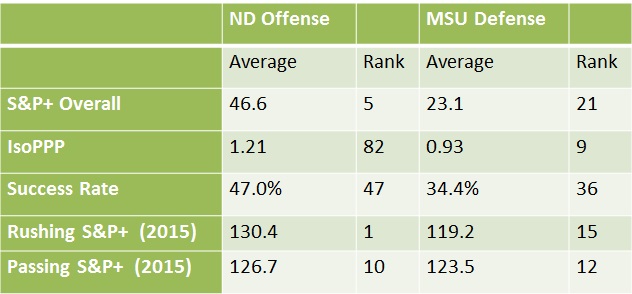
At this point, it’s pretty hard to poke holes in a Mark Dantonio defense. In the past five years the Spartans have been in the top 12 defenses (per S&P+) for four of them. They lost Pat Narduzzi last season, which spurred some questions, and then responded by improving by ten spots nationally and making the playoff.
Malik McDowell is terrifying – a five-star talent that is expected to be even better than a sophomore season where his stats were extremely similar to senior-year Sheldon Day. The rest of last year’s two-deep on the defensive line is mostly gone, with the exception of DE Demetrious Cooper, who was disruptive in limited opportunities in 2015. There’s a mix of veterans without much experience and young talent looking to fill those gaps, and it’s the unit with the most question marks on what should be a very good defense.
Michigan State has an embarrassment of riches at linebacker, with Riley Bullough headlining the group (drink every time NBC mentions all the Bulloughs that have played in East Lansing). Ed Davis received NCAA clearance to return for a 6th year, and has all-conference talent, although he may be a bit rusty and is second string.
In the secondary, the Spartans have some talented and experienced returning safeties (maybe then can lend us one!), and a few questions at corner once you get past senior Darian Hicks. Michigan State has churned out very good corners lately, but maybe this is the year they finally suffer a rough transition.
Keys for Notre Dame:
Sustain early improvement in key areas:
Especially early in the season, it seems clear that the Irish won’t be able to replicate last season’s explosiveness. Through the air, Will Fuller’s loss is too great, and while there’s a lot to like about the trio of Hunter/St. Brown/Sanders, none of them provide the deep home-run threat over the top that Mr. Esplosiva did. As Pete Sampson from Irish Illustrated point out this week on Twitter, Kizer in 2016 is 28-of-32 for 327 yards on passes traveling 20 yards or less beyond the line of scrimmage, but just 1-of-9 on passes 20+ yards downfield (including his only pick).
On the ground, it’s going to take some time for new starts on the offensive line to gel, and there’s a definite drop-off in explosiveness subbing out C.J. Prosise for Tarean Folston in the running game. I’m optimistic both areas can improve as young players gain experience, but a drop-off was likely inevitable, and we’ve seen a substantial one through two games.
But off-setting this decline has been increased efficiency in key situations – on 3rd and short and scoring opportunities. After averaging 4.19 points per red zone trip last season, the Irish are up to 5.67 early in 2016. And while as Brendan pointed out yesterday that red zone conversions are often overrated, and I agree, taking care of the ball in the red zone is not – and so far the Irish have avoided turnovers that are huge swings in expected points.
Pound the ball vs. spread them out?
This will be the chess match the coaches play on Saturday – how will the Irish offense respond to lots of bodies around the line of scrimmage? The Spartans love to play physical man coverage, and while Malik McDowell is a one-man “gamewrecker”, to use Brian Kelly’s terminology, the Spartans have a ton of new faces on the defensive line and allowed the mighty Purple Paladins to run at near-average efficiency rate (41% success) in their opener.
Given the wealth of linebacking talent, I’d expect a lot of congestion and aggression from the Spartans, both because of personnel matchups and their identity. If the run game is slow early, as it was last season at Clemson and Ohio State, will the offense spread it out given their early success with DeShone Kizer picking apart defenses?
To my untrained eye, the tight ends haven’t been overly impactful in blocking and are totally absent in the passing game (just two targets in two games). So why not test Michigan State’s linebackers in coverage on speedy guys like C.J. Sanders and Corey Holmes, or see how far they’ll dip into their reserves of relatively young corners? DeShone Kizer (as well as jet sweeps) can still provide running threats, but this could be an untraditional occasion where the passing game opens up running opportunities.
Predictions
FEI: Notre Dame 31, Michigan State 25
S&P+: Notre Dame 37, Michigan State 32
MB: Michigan State 24, Notre Dame 23. I can’t shake the feeling that some of the defensive weaknesses that have become BVG’s calling card will pop up again in this one. Turnovers will be a key, and I’d bet on the Spartans defense to force more than the Irish – there seems to be a lot of optimism coming from the surprisingly competitive Furman game, but MSU played poorly against bad competition last year and well against quality opponents. There’s a lot to like about the matchup for Notre Dame, but I’m going pessimistic until they prove me wrong.

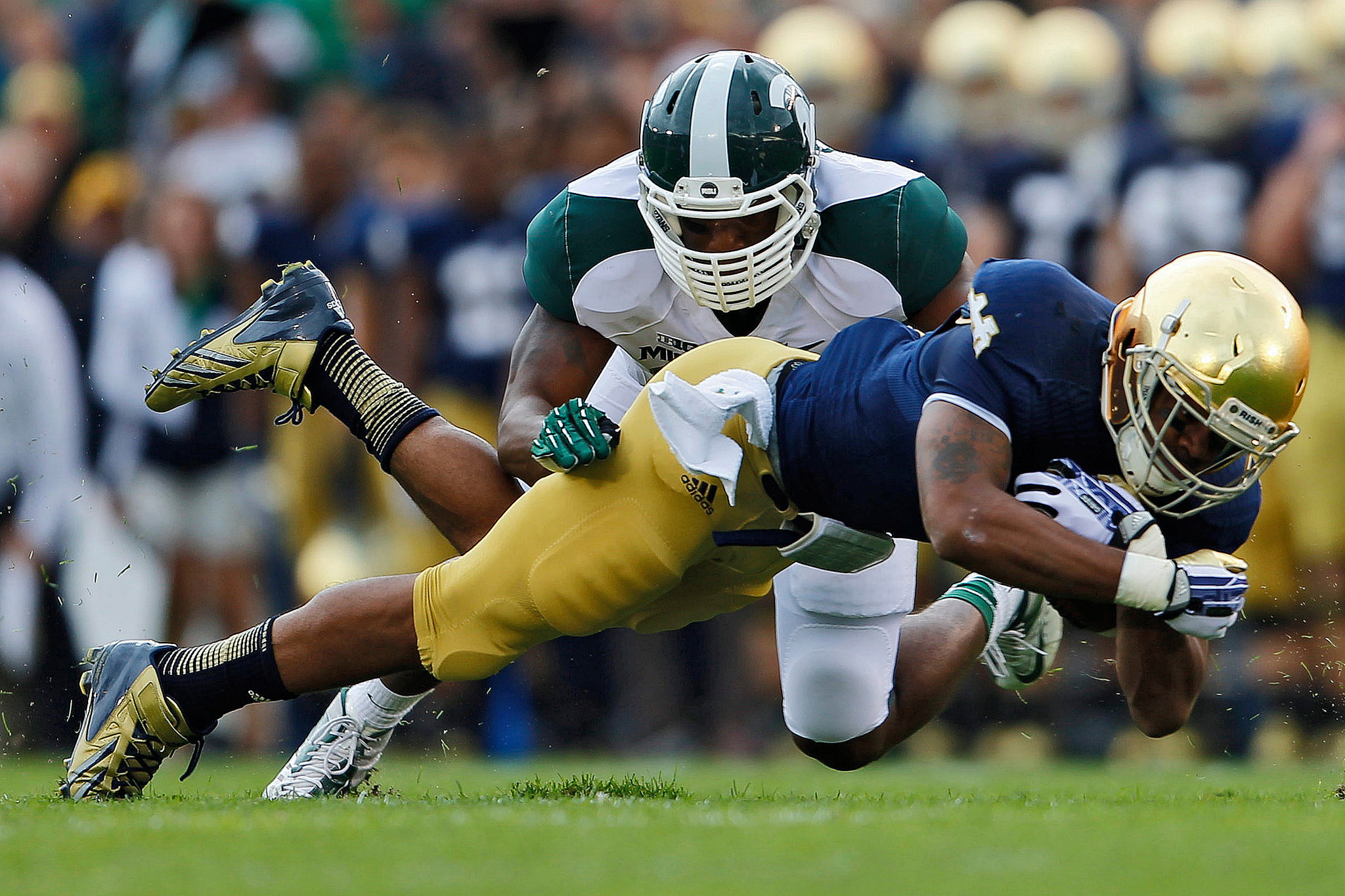
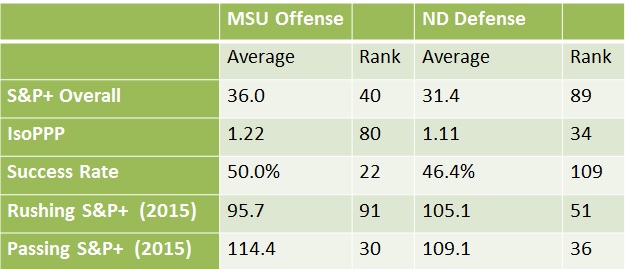
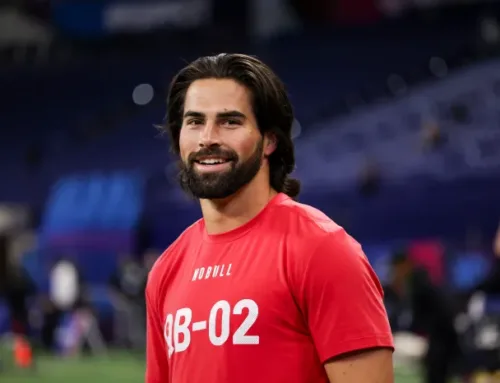
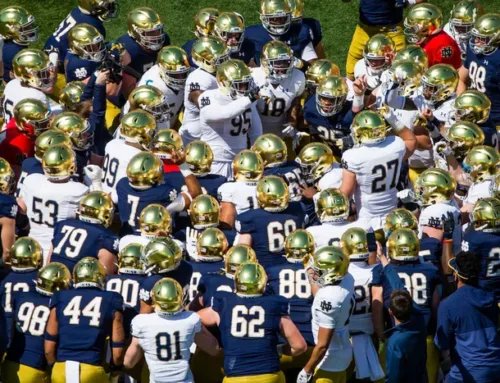
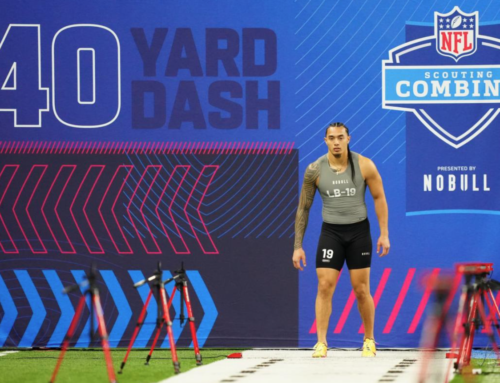
If you’re not predicting ND to win every game they play, WHAT ARE WE EVEN DOING HERE?!?! That’s what the rest of the internet is for.
So far there’s been a negative correlation between my predictions and what happens on the field (either W/L or covering the spread) so doing my best to make sure that continues
“DeShone Kizer (as well as jet sweeps) can still provide running threats,”
This terrifies me. More than any other Kelly team, I think this team is extremely dependent on its QB. If he gets hurt, we are in big doo-doo.
QB2 from 2010 to 2014:
2010 – Tommy Rees (FR)/Nate Montana (FR)
2011 – Dayne Crist (SR)/Andrew Hendrix (RS FR)
2012 – Tommy Rees (JR)
2013 – Andrew Hendrix (RS JR)
2014 – Malik Zaire (RS FR)
QB2 now: Malik Zaire (RS JR)
I think we’re in better position than we’ve been at any point since Jarious Jackson was backing up Ron Powlus. We would definitely take a step back on offense, but I don’t think it would totally go down the toilet. Plus, I don’t expect Kelly to overexpose Kizer – he knows how critical Kizer is too.
2015: DeShone Kizer (RS FR)
I think we were in a better position with our backup last year.
Sorry had to be a twit. But I agree, our 3rd stringer is better than a lot of those 2nd options from previous years.
I was being obtuse (Shawshank reference)… I forget why I left out 2015, but I had some sort of logic behind it. Unassilable logic, I’m sure. Anyway – I was viewing this more as “QB2 once the situation was settled,” so under that criterion QB2 last year was really Wimbush (FR), which is less confidence-inspiring than Zaire (RS JR). Return twittage engaged.
Also, I agree, Wimbush (SO) would’ve been QB2 on any of those 2010-2013 teams and in a dogfight with Zaire (RS FR) for QB2 in 2014.
I’m inclined to pick ND simply due to Kizer. He looks ready to carry the team, and I’m convinced he would have against TX if Kelly had been courageous enough to settle the QB battle before the game.
[…] Advanced stats preview: Michigan State […]